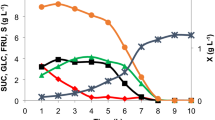Abstract
Differences in invertase accumulation of Hansenula anomala cultivated in ammonium and nitrate are reported. Media supplemented with sucrose and ammonium sulfateas the solecarbon and nitrogen source, respectively, show strong media acidification (pH 3.0 or lower), and vigorous cell growth. Invertase activity was not detected under such conditions. A cell-free imitation experiment suggests that, under such low pH, extensive chemical break-down of sucrose (>22%) occurs. Thus, H. anomala is able togrow under strong acidic conditions that permit sucrose metabolism by the uptake of monosaccharides generated from chemical hydrolysis. In addition, invertase activity is not present in cells grown in nitrate as nitrogen source at pH 5.0, but at pH 7.0 activity is detected. If ammonium is supplied instead of nitrate, cells grown at pH 5.0 show invertase activity and at pH 7.0 high levels of activity are detected. These results indicate a specific physiological response of the sucrose metabolism to the presence of alternate nitrogen source.
Similar content being viewed by others
References
De la Fuente, G. and Sols, A. (1962), Biochim. Biophys. Acta. 56, 49–62.
Zárate, V. and Belda, F. (1996), J. Appl. Bacteriol. 80, 45–52.
Chávez, F. P., Rodriguea, L., Díaz, J., Delgado, J. M., and Cremata, J. A. (1997), Biotechnol. 53, 67–74.
Gancedo, J. M. and Gancedo, C. (1986), FEMS Microbiol. Lett. 32, 179–187.
Entian, K. D. (1986), Microbiol. Sci. 3, 366–371.
Kreger-van Rij, N. J. W. (1984), The Yeast, 3rd ed., Elsevier, Amsterdam.
Barnett, J. A., Payne, R. W., and Yarrow, D. (1983), Yeast: Characteristics and Identification, Cambridge University Press, Cambridge.
Silver, W. S. (1957), J. Bacteriol. 73, 241–246.
Pichinoty, F. and Metenier, G. (1967), Ann. l'Institut Pasteur (Paris). 112, 701–712.
Minagawa, N. and Yoshimoto, A. (1983), Agric. Biol. Chem. 48, 1907–1909.
Chouldary, V. P. and Ramanda, R. G. (1976), Biochem. Biophys. Res. Comm. 72, 598–602.
Wickerham, L. J. (1986), J. Bacteriol. 52, 293–301.
Borzani, W. (1986), Rev. Brasil Eng. 3, 35–61.
Meyer, J. and Matile, P. (1975), Arch. Microbiol. 103, 51–55.
Viola, A. M., Bortesi, T., Pizzigoni, R., Puglisi, P. P., Goffrini, P., and Ferrero, I. (1986), Antonie van Leeuvenhoek. 52, 295–308.
Bradford, M. M. (1976), Ann. Biochem. 72, 248–254.
Nierderel, J. B. (1942), Micromethods of Quantitative Organic Analyses, Wiley, London.
Author information
Authors and Affiliations
Rights and permissions
About this article
Cite this article
de Medeiros, M.B., Barroso de Carvalho, P.M. Invertase production is related to the nitrogen source in Hansenula anomala . Appl Biochem Biotechnol 77, 181–189 (1999). https://doi.org/10.1385/ABAB:77:1-3:181
Issue Date:
DOI: https://doi.org/10.1385/ABAB:77:1-3:181




